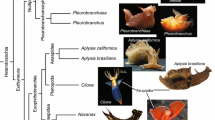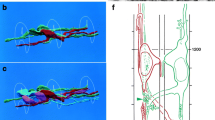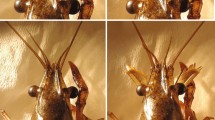Summary
We have studied the escape-swimming behavior and neurophysiology ofTritonia hombergi and compared it with another species,Tritonia diomedia in an effort to determine some of the neurophysiological correlates of the modifications in the behavior brought upon by evolution. The general form of the responses in the two species is similar. However, there are well-defined differences in the facility with which the response can be elicited, and in the parameters of response duration over repeated trials (Fig. 2).T. hombergi has many neurons that are homologous in terms of relative size, pigmentation, location and function when compared toT. diomedia (Fig. 3). We attribute the reduced probability of initiation of escape-swimming inT. hombergi to specific alterations in the condition of the central neurons (TGN's) responsible for triggering it. It was found that; (i) these neurons produce weaker responses to appropriate stimuli (Fig. 4), (ii) there are substantially fewer such neurons and, (iii) there are neurons on the margins of the group with reduced regenerative firing capabilities (Fig. 5). Since the TGN's are electrically coupled to these latter neurons, it is suggested that the regenerative excitability of the TGN system as a whole is reduced by the loading effect of these less excitable neurons. It is proposed that the TGN system and consequently the escape-swimming response ofT. hombergi are in a transitional state in evolutionary terms. The small size of the TGN group and its interactions with nearby neurons are consistent with the idea that it is either recruiting or losing efficacy as the adaptive value of the behavior changes.
Similar content being viewed by others
References
Abraham, F. E., Willows, A. O. D.: Plasticity of a fixed action pattern in the sea slugTritonia diomedia. Comm. Behav. Biol. (A)6, 271–280 (1971)
Alder, J., Hancock, A.: A monograph of the British nudibranchiate mollusca. London: Ray Society 1909
Bennett, M. V. L.: A comparison of electrically and chemically mediated transmission. In: Structure and function of synapses (ed. G. D. Pappas, D. P. Purpura), p. 221–256. New York: Raven Press 1972
Bentley, D. R.: Genetic control of an insect neuronal network. Science174, 1139–1141 (1971)
Brennecke, R., Lindemann, B.: A chopped current clamp for current injection and recording of membrane polarization with single electrodes of changing resistance. T.-I.-T. J. Life Sci.1, 53–58 (1971)
Dorsett, D. A.: Giant neurons and axon pathways in the brain ofTritonia. J. exp. Biol.46, 137–151 (1967)
Dorsett, D. A., Willows, A. O. D., Hoyle, G.: The neuronal basis of behavior inTritonia. IV. The central origin of a fixed action pattern demonstrated in the isolated brain. J. Neurobiol.4, 287–300 (1973)
Getting, P. A., Willows, A. O. D.: Burst formation in electrically coupled neurons. Brain Res.63, 424–429 (1973)
Hotta, Y., Benzer, S.: Abnormal electroretinograms in visual mutants ofDrosophila. Nature (Lond.)222, 354–356 (1969)
Hoy, R. R., Paul, R. C.: Genetic control of song specificity in crickets. Science180, 82–83 (1973)
MacFarland, F. M.: Studies of Opisthobranchiate mollusks of the Pacific Coast of North America. Mem. Calif. Acad. Sci.6 (1966)
Mauzey, K. P., Birkeland, C., Dayton, P. K.: Feeding behavior of asteroids and escape response of their prey in the Puget Sound region. Ecology49, 603–619 (1968)
Sidman, R. L.: Development of interneuronal connections in brains of mutant mice. In: Physiological and biochemical aspects of nervous integration (ed. F. D. Carlson), p. 163–193. New York: Prentice Hall, Inc. 1968
Strumwasser, F.: The demonstration and manipulation of a circadian rhythm in a single neuron. In: Circadian clocks (ed. P. Aschoff), p. 442–462. San Francisco: North Holland Publishing Co. 1965
Willows, A. O. D.: Behavioral acts elicited by stimulation of single identifiable neurons. Science157, 570–574 (1967)
Willows, A. O. D.: Learning in Gastropod Mollusks. In: Invertebrate learning (ed. W.C. Corning, J. A. Dyal, A. O. D. Willows), p. 187–274. New York: Plenum Press 1973
Willows, A. O. D., Dorsett, D. A., Hoyle, G.: The neuronal basis of behavior inTritonia. I. Functional organization of the central nervous system. J. Neurobiol.4, 207–237 (1973a)
Willows, A. O. D., Dorsett, D. A., Hoyle, G.: The neuronal basis of behavior inTritonia. III. Neuronal mechanism of a fixed action pattern. J. Neurobiol.4, 255–285 (1973b)
Willows, A. O. D., Getting, P. A., Thompson, S.: Bursting mechanisms in molluskan locomotion. In: Control of posture and locomotion (ed. R. B. Stein, K. G. Pearson, R. S. Smith, J. B. Redford), p. 457–475. New York: Plenum Press 1973
Willows, A. O. D., Hoyle, G.: Neuronal network triggering a fixed action pattern. Science166, 1549–1551 (1969)
Author information
Authors and Affiliations
Additional information
This work was supported by Grant No. B/SR/0661.8 to Derek A. Dorsett and by N.S.F. Research Grant GB 33720X to A.O.D. Willows. We are grateful for the assistance of Mr. Robert Reinstatler and Mr. Anthony Atkinson in design and construction of the ‘sample and hold’ unit.
Rights and permissions
About this article
Cite this article
Willows, A.O.D., Dorsett, D.A. Evolution of swimming behavior inTritonia and its neurophysiological correlates. J. Comp. Physiol. 100, 117–133 (1975). https://doi.org/10.1007/BF00613964
Received:
Issue Date:
DOI: https://doi.org/10.1007/BF00613964




